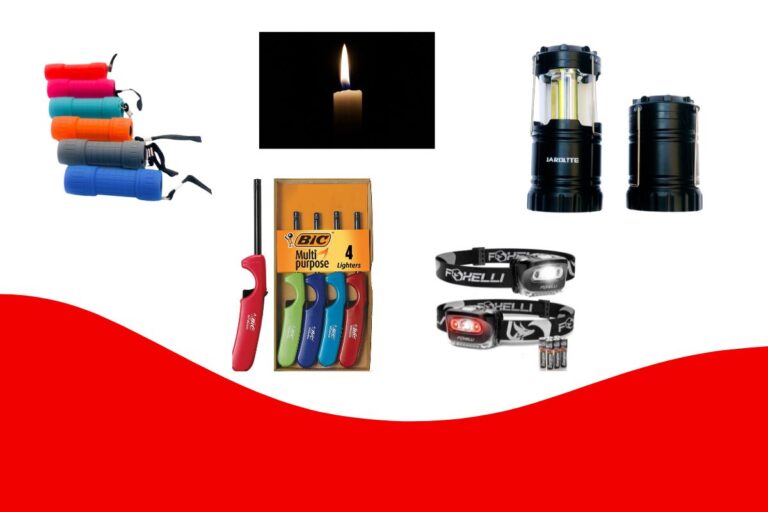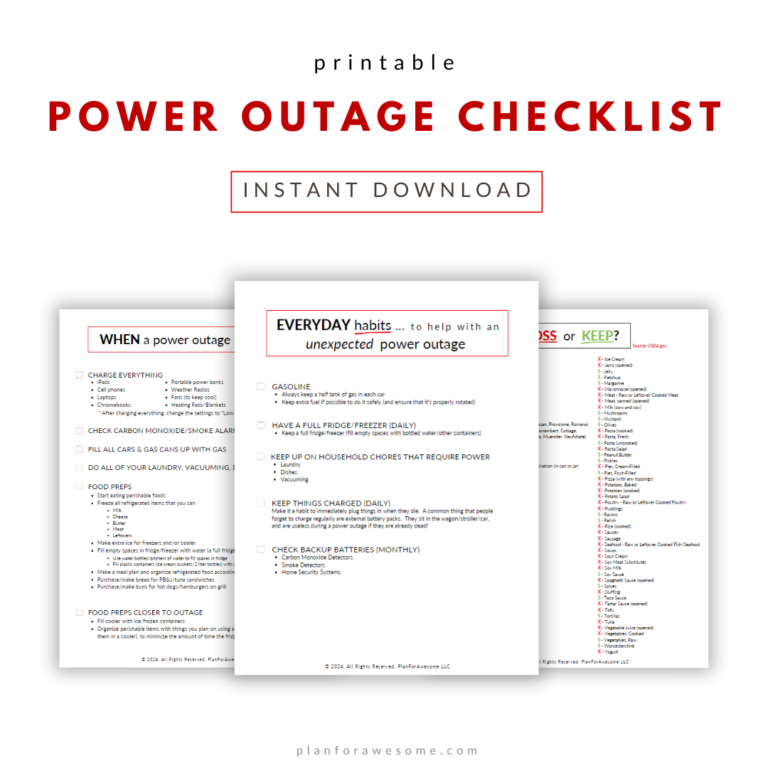
The ultimate guide to Prepare for a Hurricane
Do you know what it takes to prepare for a hurricane? Learn what to do before a hurricane, how to prepare for evacuation and get a hurricane preparedness list

**This post contains affiliate links, which means if you click on a link and make a purchase, I may make a small commission at no extra cost to you.
A lengthy power outage can happen anytime, anywhere. I happen to live in California where there have been times our power company warns of planned power outages during wildfire season. It’s not fun, but I do appreciate the heads up so my family can prepare.
Anyone who lives in an area where lengthy power outages are a likely outcome of a natural disaster in your area (hurricanes, wildfires, tornados, earthquakes, etc – so pretty much everywhere) would do well to read this and prepare for a potential power outage.
This is the first post in a 3 part series on how to prepare for a power outage.
Click here to go directly to the 2nd part which is all about things you can do throughout the year to be preparing for a power outage.
Click here to go directly to part 3 where I’m sharing what to do right before and during a power outage.
This is NOT something you want to leave until an announcement is made, or until a weather report comes out for the upcoming week. It will be too late for many of these things. I can attest to this from firsthand experience. While my examples are not of life and death, these two instances were definitely wake-up calls for me.
Case #1 –
I was living in Alabama when Hurricane Ivan came through. As with most hurricanes, we had a few days’ notice. You should have seen Walmart, y’all! It was UNREAL; almost creepy walking through the aisles. Some aisles were totally normal and fully stocked (like the toys and furniture/bedding). And then other aisles were just plain EMPTY. No joke. The camping section, food, baby necessities, personal hygiene items, flashlights, lanterns, you name it. Gone. It was like you see in the movies. Crazy.
Case # 2 –
A few years ago, after the Campfire in Paradise, CA had been going for a few days, the smoke where we live was REALLY BAD. We live two hours away, but the smoke was so bad that my kids’ school was canceled. So bad that I walked outside to get the mail and came back in with real pieces of ash in my hair.
Not one N-95 mask could be found within 200 miles of us. It was nuts. Even AMAZON was out! I thought I was so smart going to Amazon to order some, but there was a 2-week shipping delay.
If you are looking for some N95 Masks, this 10-pack makes them each about $1.50.
I cannot emphasize this enough: Start preparing NOW.
I would recommend having a minimum of one flashlight (AND BATTERIES) per person in your family. This is just as important for your family’s psychological well-being as it is for their physical well-being. Even (and especially) for little kids, having a flashlight that they are in control of can be an incredibly calming influence in a time that is likely to cause a high level of anxiety, depending on the person.
I like this variety pack of flashlights because you get 6 flashlights for $14.99, and each flashlight is a different color. This makes it easy to keep track of whose is whose if you have a few people in your family. I also like their small size, making it convenient to keep them in a drawer, next to a bed, etc.
Handheld flashlights are great, but so are headlamps. The headlamp option is nice because it’s a hands-free source of direct light.
This is my favorite pick for headlamps. It’s comfy, waterproof, and as stylish as possible, given what it is. However, this 2-pack looks like a GREAT deal, and the reviews are pretty good. I’m not sure I would love the over-the-head strap, but it says that is removable. It also looks like the batteries that come with it are pretty short-lasting, but that’s an easy fix – just be prepared with spare batteries!
Lanterns definitely have their place in an extended power outage situation. You don’t want to have to hold a flashlight for 5 days straight, or even wear a headlamp. Lanterns are the closest thing you have to a steady light that goes in all directions.
My favorite ones are these. They are small, inexpensive, only take 4 AA batteries, and they even have convenient handles on the top to hang them on a hook. They’re also magnetized on the bottom (we store ours on the side of our fridge). The biggest difference between these and other brands, is these also have a flashlight function, where you can use it for directional light. This is truly the most versatile lantern out there!
There’s no good place to put batteries in this line-up, because I feel like it should be mentioned after almost every topic. I cannot emphasize enough the importance of batteries.
Don’t leave this stuff in the packaging until the power outage occurs. Open them up, check to see what kind of batteries all of these things take, and make sure you have plenty of extras. I always buy our batteries at Costco, and I try to stay ahead of our battery usage so I am not forced to buy them before they go on a coupon (Duracell batteries go on coupons all the time at Costco).
This is a cheaper way to get the lantern effect. However, if you go with this option, be EXTREMELY careful having open flames in your home. I prefer battery-powered lanterns for a power outage because they’re the safest option.

If you don’t have one of these external chargers, order one (or 2) ASAP. These are game changers. I bought one a couple years ago when we had season passes to Six Flags and my phone was always dead by the end of the day, being without a charger and using it to take a million pictures and videos.
Imagine the value of this in a 5-day extended blackout! Charge your phones, iPads, tablets, Airpods, etc. Obviously one of these is not going to last 5 days charging multiple devices, so plan on using the charge wisely, or buy a couple of these to double the amount of charge you can go into the blackout with.
Make sure the following things in your home have batteries installed for the built-in battery backups. Check to see what types of batteries each thing uses, and have replacement batteries on hand.
Did you know that corded phones still work, even when the power is out?? Cordless phones won’t work though, since the base of a cordless is powered through an outlet. If you pay for a landline, you will still have access to make phone calls if you have a corded phone. If you’re curious as to how this works, this short article from How Stuff Works explains it 🙂
Helpful tip: If you do not pay for a phone service, find a neighbor who does, and ask if they would mind if you plugged into their phone line during possible lengthy blackouts. You could even offer to buy them a corded phone (because seriously, who has one anymore?!) in exchange for you borrowing their connection.
Make a list of important phone numbers (including emergency phone numbers) and addresses and WRITE THEM DOWN. You will not have access to your cell phone if you have run out of power to charge it, and if you’re like me, the only phone number you know by heart anymore is your own. Get this list made and ready to use!
Printing out a few pages from your Information Hub, and storing them in a binder, would be a great way to have this kind of thing ready to go should you find yourself in an extended power outage.
If you want updates on current conditions, you’ll want a radio of some sort. We have this crank flashlight/radio and we are happy with it. The radio works, the flashlight works, it has a battery, solar, AND a crank-powered option. It also has a USB port to charge electronics. We have not tested the solar function but have tested everything else and it all works.
This is certainly not necessarily THE ONE I would recommend; there are countless options of flashlights, radios, chargers, etc. We’ve had this one for over a decade, so I’m sure there are better ones out there now…
One thing to keep in mind is that while a crank option sounds appealing since it never expires (like batteries do), many products require quite a bit of crank for very little power. So while it is a nice backup option, batteries are a lot more convenient and produce immediate power!

This is covered more in depth in Part 3, which is all about what you can be doing throughout the year, but right now you can get a thermometer inside your fridge and your freezer, so you know what temperature your food is at when power is restored. If the temperature inside your fridge has been 40 degrees or above for over 2 hours, you should throw out your food.
I like this one because it comes with 2 sensors (one for your fridge and one for your freezer), and then a display that you keep OUTSIDE of your fridge/freezer. That way you can see the temperature inside your fridge/freezer without having to open the door. This is HUGE in stretching your food through a power outage because you aren’t letting the cold air out just to open the door to check the temperature.
Be sure to get one for each fridge and freezer that you own. Don’t forget the ones in the garage!
Again, I’ll cover this later in the series, but for now, make sure you have a good cooler. This could be key in saving the food that is in your fridge and freezer. If you have a cooler to hold the foods you will use in the first several hours of the power outage, you can leave your fridge and freezer closed for longer, which will drastically increase the likelihood of your food coming out of the power outage unspoiled.
As with anything in this world, the more you spend, the better quality of product you get (usually). If you’ve had your eye on a top-of-the-line cooler, now you have a legit reason to splurge. And with Father’s Day coming up, you could take care of a Father’s Day present while also getting prepared for this upcoming fire season…
The first time I saw a Yeti cooler I was out shopping at a sporting goods store, and I think I made an audible gasp. What kind of crazy person would spend $400 on a cooler?! Ridiculous! After doing my research, I am more and more convinced that it’s not as ridiculous as I once thought. The coolers we own keep ice cold for 2-3 days. A Yeti keeps ice cold for 10 days. And then there are many others in between.
A few reasons for Yeti’s superiority are their secure latches, their air tight gaskets, and their metal construction, combining to be the top-rated coolers on the market.
My favorite Yeti is this one (lots of Yetis don’t have wheels but this one does). This one is $399.99 regardless of where you get it (Amazon, sporting goods stores, Yeti.com, etc).
Oh, and this 4-lb ice pack (affiliate link) is pretty amazing too ($29.99 whether on Amazon or YETI.com). It literally stays frozen for a few days, when inside a Yeti cooler. It’s huge, it’s awesome, and it’s worth every penny. My husband takes it in his work cooler every day. It has been a great purchase.
Talk to your doctor about a plan for refrigerated medicines. Find out how long medication can be stored at higher temperatures, so you have this knowledge before you need it.
Remember my experience I shared at the beginning of this post, with entire aisles of Walmart being empty? Stock up on things you use on a daily basis NOW, so you don’t have to compete with everyone else who is freaking out as soon as PG&E issues their first warning.
One thing that is specific to wildfires is N95 Masks. From PERSONAL EXPERIENCE, order these NOW. This 10-pack makes them each about $1.50.
Here is a list of ideas for meals you can eat during a power outage that require little or no heat and would be a good idea to stock up on now (remember, don’t be too incredibly scared of refrigerated items, as long as you are open to the idea of keeping a cooler filled with the items you plan on using, once the power outage starts):

If you have a gas stove, you will still be able to light it and use it as normal (you will need a lighter or a match to get it started, but that’s it). I would recommend using a long-handled lighter.
If you have an electric stove, you will want an alternative way to cook food (or even just heat up water to add to a Cup O’ Noodle).
You can use your outdoor grill for cooking, but you won’t want to put your normal kitchen pots and pans on a grill. It will turn them black forever (speaking from experience).
If you already have a camping stove in your stash, this is a great backup plan for cooking your food. Be sure you have plenty of fuel on hand!
This is the camping stove we got. It’s very reasonably priced and easy to use. However, I was not able to order the butane (fuel canisters) on Amazon because they wouldn’t deliver it to my address. So we just got our fuel at a physical store. Note: you should not use a butane stove indoors. The fumes can cause carbon monoxide poisoning. Always use these outside!
If you don’t want to have to go outside and use your BBQ or fire pit to heat up food, canned heat is great because you can use it indoors. You can purchase a foldable stove for $10, and stick the canned heat underneath.
This is definitely not a powerful cooking method, and isn’t ideal for cooking foods. But if you are prepared with food that just needs to be heated up (like a can of soup) or that just requires boiling water, this does the trick!
If power is out, so are credit card machines. Having a decent amount of cash on hand can prove incredibly useful in periods of extended power outages.

Think through some things you will want to do to keep busy while the power is out, especially if you have little kids. And be sure to think it ALL the way through.
For example, if you are accustomed to being able to run over to your computer and print coloring pages your kids are asking for that you search out on google, you won’t be able to do that during a power outage.
If you are the type of person who likes to scour Pinterest for ideas of things to do with your kids, do this ahead of time. You won’t have access to your computer, and you won’t want to use up precious battery life on your phone to search for ideas on Pinterest. Start that process now, before fire season begins.
If you usually have a family movie night every weekend, you’ll want to have an alternative family activity night (that does not require electricity) planned and ready to execute.
Most (if not all) power companies will attempt to alert customers of potential power outages via texts, emails, and phone calls. Be sure they have your correct contact information so you can receive alerts. Any amount of warning is better than none, so double check your contact information!
Okay, that’s all for now. Remember, one step at a time. Doing something is always better than doing nothing when it comes to emergency preparedness.
Work through these 10 steps and then move on to the next post which covers things you should be doing throughout the year. When you stay on top of it, you won’t be scrambling at the last second when a power outage is imminent.
And if you’re interested in having access to the printable checklist, you’ll definitely want to check out the Power Outage workshop! Members of the Personalized Preparedness Membership have access to this workshop and others on a variety of preparedness topics. But, you can also purchase the workshop separately and get a link to download the Power Outage Checklists.


Do you know what it takes to prepare for a hurricane? Learn what to do before a hurricane, how to prepare for evacuation and get a hurricane preparedness list

There will always be things we don’t think about before we encounter an emergency. But, I’m here to help you think about some of the non-food storage items you might want to keep on hand for the next rainy day.

Berkey water filters are THE BEST water filters, not only for emergencies, but for everyday use. They are so good, they are classified as a water purifier, which is a step up from a filter!
